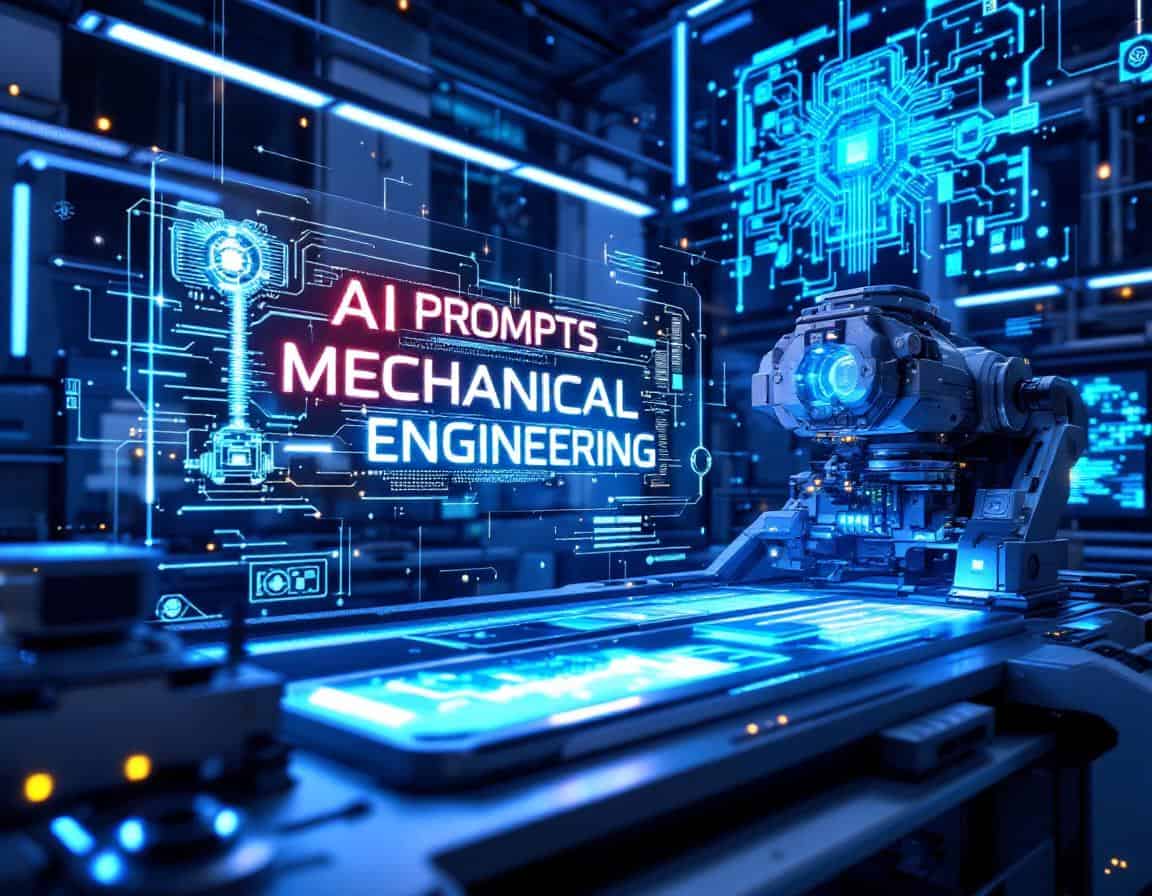
Online AI tools are rapidly transforming mechanical engineering by augmenting human capabilities in design, analysis, manufacturing, and maintenance. These AI systems can process vast amounts of data, identify complex patterns, and generate novel solutions much faster than traditional methods. For instance, AI can assist you in optimizing designs for performance and manufacturability, accelerate complex simulations, predict material properties, and automate a wide range of analytical tasks.
The prompts provided below will for example help on generative design, accelerate simulations (FEA/CFD), help on predictive maintenance where AI analyzes sensor data from machinery to forecast potential failures, enabling proactive servicing and minimizing downtime, help on material selection and much more.
- This page is specific for one domain. If necessary, you can have full search capabilities accros all domains and all criteria in our > AI Prompts Directory <, dedicated to product design and innovation.
- Given the server resources and time, the prompts themselves are reserved to registered members only, and not visible below if you are not logged. You can register, 100% free:
- Root Cause Analysis
- Mechanical engineering
AI Prompt to Fault Tree Analysis Builder
- Failure analysis, Failure Mode and Effects Analysis (FMEA), Fault Tree Analysis (FTA), Mechanical Engineering, Process Improvement, Quality Control, Quality Management, Risk Analysis, Risk Management
This prompt requests the AI to construct a fault tree analysis diagram in text format for a given mechanical system failure event. The user provides the failure event description and components involved.
Output:
- Markdown
- does not require live Internet
- Fields: {failure_event} {system_components}
- Best for: Best for visualizing failure propagation and dependencies in mechanical systems
- Root Cause Analysis
- Mechanical engineering
AI Prompt to Failure Mode Prioritization Matrix
- Continuous Improvement, Corrective Action, Failure analysis, Failure Mode and Effects Analysis (FMEA), Process Improvement, Quality Control, Quality Management, Risk Analysis, Risk Management
This prompt asks the AI to create a failure mode prioritization matrix based on a CSV input of failure modes, their severity, occurrence, and detection ratings. It helps prioritize root causes for mechanical failures.
Output:
- CSV
- does not require live Internet
- Fields: {csv_failure_modes}
- Best for: Best for quantitatively prioritizing failure investigations and corrective actions
- Root Cause Analysis
- Mechanical engineering
AI Prompt to Root Cause Analysis Report Generator
- Continuous Improvement, Corrective Action, Failure analysis, Lean Manufacturing, Process Improvement, Quality Assurance, Quality Management, Root Cause Analysis, Statistical Process Control (SPC)
This prompt instructs the AI to generate a detailed root cause analysis report for a mechanical failure incident based on a provided incident summary, test results, and inspection findings. It synthesizes information into a structured document.
Output:
- Markdown
- does not require live Internet
- Fields: {incident_summary} {test_results} {inspection_findings}
- Best for: Best for producing formal, structured root cause analysis documentation
- Ethical Consideration and Impact Analysis
- Mechanical engineering
AI Prompt to Ethical Framework for Autonomous Machinery
- Advanced Driver-Assistance Systems (ADAS), Artificial Intelligence (AI), Autonomous Vehicle, Design Thinking, Human-Centered Design, Risk Management, Robotics, Safety
Generates a framework for ethical considerations in designing autonomous mechanical systems focusing on safety accountability and decision-making in unforeseen scenarios. This prompt helps engineers proactively address ethical challenges during the design phase of complex machinery. The output is a structured markdown document.
Output:
- Markdown
- does not require live Internet
- Fields: {autonomous_system_type} {operational_environment_description} {key_decision_making_scenarios_csv}
- Best for: Proactively developing ethical guidelines for autonomous mechanical systems helping engineers navigate complex moral decision-making in design and operation.
- Ethical Consideration and Impact Analysis
- Mechanical engineering
AI Prompt to Lifecycle Environmental Impact Assessment Outline
- Circular Economy, Eco-Friendly Manufacturing, Environmental Impact, Environmental Impact Assessment, Life Cycle, Life Cycle Assessment (LCA), Sustainability Practices, Sustainable Development, Sustainable Product Design
Outlines key stages and considerations for conducting a lifecycle environmental impact assessment (LCA) for a new mechanical product. This prompt helps engineers structure their LCA efforts by identifying data needs impact categories and mitigation opportunities. The result is a markdown document detailing the LCA plan.
Output:
- Markdown
- does require live Internet
- Fields: {product_name_and_function} {bill_of_materials_csv} {manufacturing_processes_overview_text} {expected_use_phase_and_disposal_text}
- Best for: Structuring the lifecycle environmental impact assessment of mechanical products enabling engineers to systematically evaluate and mitigate environmental footprints.
- Ethical Consideration and Impact Analysis
- Mechanical engineering
AI Prompt to Societal Impact Analysis of Automation
- Change Management, Industrial Automation, Mechanical Engineering, Sustainability Practices
Analyzes the potential societal impacts such as employment shifts skill demand changes and accessibility issues arising from implementing a specific automation technology in a mechanical engineering sector. This prompt helps engineers consider broader societal consequences. The output is a text-based report.
Output:
- Text
- does require live Internet
- Fields: {automation_technology_description} {industry_sector_of_application} {geographical_region_context}
- Best for: Analyzing potential societal consequences of automation in mechanical engineering such as employment shifts and skill demand helping to inform responsible technology adoption.
- Ethical Consideration and Impact Analysis
- Mechanical engineering
AI Prompt to Dual-Use Technology Ethical Assessment
- Additive Manufacturing, Design for Additive Manufacturing (DfAM), Environmental Impact, Mechanical Engineering, Risk Management, Sustainability Practices
Conducts a preliminary ethical assessment for a mechanical engineering technology that may have dual-use applications highlighting potential risks ethical dilemmas and proposing safeguards. This prompt aims to foster responsible innovation by considering unintended consequences. The output is a structured markdown report.
Output:
- Markdown
- does not require live Internet
- Fields: {technology_description_and_capabilities} {intended_civilian_application} {potential_misuse_concerns_list_csv}
- Best for: Assessing dual-use mechanical technologies for ethical risks and misuse potential guiding engineers in responsible innovation and proposing safeguards.
- Experimental Design Optimization
- Mechanical engineering
AI Prompt to Experimental Plan Critique and Improvement Suggestions
- Design Analysis, Design Evaluation, Design Optimization, Process Improvement, Quality Assurance, Quality Control, Statistical Analysis, Validation
This prompt asks the AI to analyze a provided experimental design in mechanical engineering, identifying weaknesses and proposing detailed improvements to enhance validity, reliability, and efficiency. The user inputs the experimental plan description and key variables.
Output:
- Text
- does not require live Internet
- Fields: {experimental_plan} {key_variables}
- Best for: Best for optimizing experimental setups to yield more reliable and valid results
- Grant Proposal and Scientific Writing Assistance
- Mechanical engineering
AI Prompt to Grant Proposal Significance Section Draft
- Additive Manufacturing, Design for Additive Manufacturing (DfAM), Innovation, Mechanical Engineering, Product Development, Prototyping, Research and Development, Sustainability Practices, Value Proposition
Drafts the Significance and Innovation sections for a mechanical engineering grant proposal highlighting the project’s novelty research gap addressed and potential impact. This prompt helps engineers articulate the core value of their proposed work. The output is a markdown formatted text.
Output:
- Markdown
- does not require live Internet
- Fields: {project_title} {research_problem_statement} {proposed_solution_summary} {key_innovative_aspects_list_csv}
- Best for: Assisting mechanical engineers in drafting compelling Significance and Innovation sections for grant proposals ensuring clear articulation of research value and novelty.
- Experimental Design Optimization
- Mechanical engineering
AI Prompt to Optimal Experimental Design Generator
- Design for Additive Manufacturing (DfAM), Design for Manufacturing (DfM), Mechanical Engineering, Process Optimization, Quality Assurance, Quality Control, Research and Development, Statistical Analysis
This prompt instructs the AI to design an optimal experiment to investigate specified mechanical engineering parameters. The user provides the research question, variables to test, and constraints. The AI returns a full experimental plan with control groups, sample sizes, and measurement strategies.
Output:
- Markdown
- does not require live Internet
- Fields: {research_question} {variables} {constraints}
- Best for: Best for generating comprehensive, statistically sound mechanical engineering experiments



























Are we assuming AI can always generate the best prompts in mechanical engineering? How are these generated btw?
Is AI going to make human engineers redundant?
Related Posts
Workstation Ergonomic Assessment
Engineering Change Order (ECO): Best Practices to Minimize Disruption and Cost
From Lab To Market: The Role of the Pilot Production Run
45+ More Cognitive Science Tricks for Games and Marketing: Psychological and Engagement
45+ Cognitive Science Tricks for Games and Marketing: Psychological and Engagement
Latest Publications & Patents on Zeolites